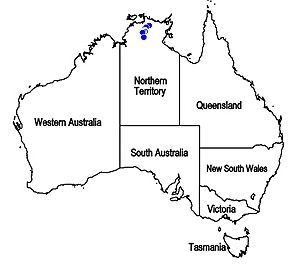Pityrodia puberula facts for kids
Quick facts for kids Pityrodia puberula |
|
|---|---|
| Scientific classification | |
| Genus: |
Pityrodia
|
| Species: |
puberula
|
 |
|
| Occurrence data from the ALA | |
Pityrodia puberula is a type of flowering plant. It belongs to the mint family, called Lamiaceae. This plant is only found in Arnhem Land in the Northern Territory of Australia. It is a shrub that grows in a spreading way. It has narrow, hairy leaves and off-white, bell-shaped flowers. These flowers have cool dark purple streaks.
Contents
What Does Pityrodia Puberula Look Like?
Pityrodia puberula is a straggling shrub. This means it grows in a loose, spreading way. It can reach about 50 centimeters (20 inches) tall. Its branches are covered with tiny, star-shaped hairs.
Leaves and Stems
The leaves of this plant are hairy. They are long and thin, like a narrow spear. They are usually 10 to 35 millimeters (0.4 to 1.4 inches) long. They are also about 3 to 6 millimeters (0.1 to 0.2 inches) wide. The top side of the leaves is mostly smooth. The bottom side has a raised line in the middle.
Flowers and Petals
The flowers grow one by one where the leaves meet the stem. They have small, leaf-like parts called bracts and bracteoles at their base. These are about 3 to 6 millimeters (0.1 to 0.2 inches) long.
The flower has five sepals. These are like small leaves that protect the bud. They are joined together to form a bell-shaped tube. This tube has five hairy, spear-shaped tips. These tips are about 7 to 8 millimeters (0.3 inches) long.
The five petals are off-white. They are 10 to 13 millimeters (0.4 to 0.5 inches) long. They also join together to form a bell-like tube. At the end of this tube are five lobes. The two top lobes have dark purple streaks. They are smaller, about 3 to 4 millimeters (0.1 to 0.2 inches) long. The lower middle lobe is bigger than the others.
The outside of the petal tube and its lobes are hairy. There is also a thick ring of hairs inside, below the stamens. The four stamens are the parts that make pollen. They stick out a little from the flower tube. The lower two stamens are slightly longer.
Fruit and Flowering Time
Pityrodia puberula mainly flowers from February to June. After flowering, it produces a fruit. This fruit is oval-shaped and a bit wrinkled. It is about 3 to 4 millimeters (0.1 to 0.2 inches) long. It is also about 2 millimeters (0.08 inches) wide.
How Pityrodia Puberula Got Its Name
The plant Pityrodia puberula was first officially described in 1979. This was done by a scientist named Ahmad Abid Munir. He found a sample of the plant near Mount Cahill in Arnhem Land. The description was then published in a science journal.
Where Pityrodia Puberula Grows
This type of pityrodia plant is found in Arnhem Land. This area includes famous places like Kakadu National Park and Nitmiluk National Park.
Is Pityrodia Puberula Protected?
The plant Pityrodia puberula is listed as "least concern." This means it is not currently at high risk of disappearing. This classification is under the Territory Parks and Wildlife Conservation Act 2000.

